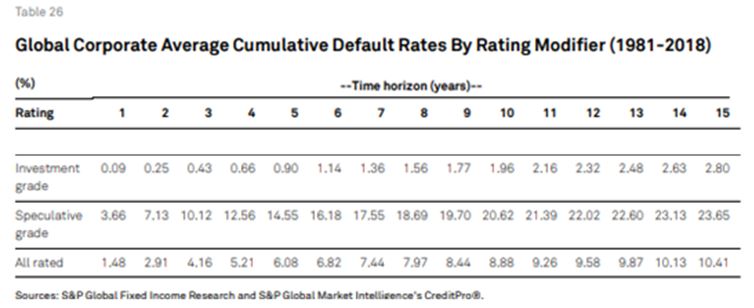Resources
Investment Grade: The Gold Standard
Promoted by XTB.
Investment Grade: The Gold Standard
Fixed income should represent the ‘safest’ part of your portfolio, so it’s important not to take undue risks. Fixed income is where your focus should be on ensuring a regular and predictable source of income. It’s not where you should expose yourself to greater risks. Indeed, 2019 has already seen some defaults from small, unrated bond issuers.
What does Investment Grade mean?
The major international credit rating agencies (S&P, Moody’s & Fitch)1 analyse the credit quality of a company and develop a rating based on their view of the company’s ability to repay its debts. Ratings of BBB- or better, using the S&P scale, are considered to be ‘Investment Grade’. Anything below this is sub-investment grade or speculative-grade, sometimes referred to as ‘junk bonds’. Ratings are periodically monitored and can change over the life of a bond.
The importance of the Investment Grade rating
An Investment Grade rating is highly important for a company. It is a vote of confidence in the future performance of the business, and dramatically affects the rate at which they can borrow from banks or bond investors. In general, if a bond issuer falls below Investment Grade, the price of their bonds should fall. In some cases, the company will have to pay a higher rate of interest (coupon) to its bond holders.
Investment Grade ratings can also affect who a company can sell their bonds to. Many professional bond fund managers are not able to hold sub-investment grade securities. This is a similar concept to equity fund managers not being able to hold securities outside the ASX200. The main hurdle to inclusion in the ASX200 is business size, determining a credit rating however, is a much more in-depth process.
Determining a credit rating
Ratings agencies take a myriad of factors into account to determine a well-balanced view of credit risk. Leverage, cash flows, earnings and a number of financial ratios are considered before assigning an investment grade rating to a specific bond.
Many financial advisers use credit ratings when comparing one bond to another, on behalf of their clients. Two bonds with the same rating, time until maturity and yield could be priced very close to each other, no matter the industry they operate in. This is very different to equities, where one research house will love a sector and another will recommend selling it.
How ratings relate to risk
The major risk of investing in bonds is the issuing company not repaying the principal or missing a coupon payment. This is known as a credit default. A credit default would have major ramifications for bond holders, but also equity holders of a company. The share price is also likely to fall if the company cannot meet its debt payments.
How often do bond issuers default?
The table below shows global default rates from companies from 1981 to 2018. The default rate for 3-year Investment Grade bonds is 0.43%. However, the default rate jumps to 10.12% for speculative grade bonds. So, when considering a bond, the risk of a credit default is substantially mitigated by sticking to those rated Investment Grade.

Investment Grade defaults in Australia have been very rare, with only two in the past 30 years – Babcock & Brown and Pasminco.
Exposure to Investment Grade bonds on ASX
There’s a broad range of bond ETFs available, and a number of Credit Funds have also recently listed on ASX. However, being pooled investments these can include a wide range of bonds across many credit ratings. They have certainly made access to bonds much simpler for ASX investors. However, they may include hundreds of bonds and possibly other debt obligations, so knowing what you’re invested in is harder.
One way of ensuring what you are invested in is by sticking with individual corporate bonds. This approach allows you to focus on bonds issued by companies you know and trust – those with the investment-grade badge. Exposure to these bonds is also available to investors on ASX in the form of XTBs (Exchange Traded Bond units). There are currentlyclose to 50 XTBs trading on ASX.Investors canselect from companies such as Telstra, AGL, Qantas or Westpac to name a few, all of which are currently investment grade.
1 In Australia S&P, Moody’s and Fitch have Australian Financial Service Licences that authorises them to provide general advice in the form of a credit rating to wholesale investors only.

Disclaimer
The information in this article is general in nature. It should not be the sole source of information. It does not take into account the investment objectives or circumstances of any particular investor. You should read the PDS that relates to that Class of XTB prior to making an investment decision and consider, with or without advice from a professional adviser, whether an investment is appropriate to your circumstances. Australian Corporate Bond Company Limited is the Securities Manager of XTBs and will earn fees in connection with an investment in XTBs.
Give XTBs a try with brokerage-free trading from Bell Direct
Web: https://xtbs.com.au/what-are-xtbs/
Email:
Tel: 1800 995 993
Join Bell Direct today: https://www.belldirect.com.au/smarter/

Sponsored features
Dissecting the Complexities of Cash Indices Regulations: An In-Depth Analysis
Introduction In recent years, the world of finance has seen a surge of interest in cash indices trading as investors seek potential returns in various markets. This development has brought increased ...Read more

Sponsored features
The Best Ways to Find the Right Trading Platform
Promoted by Animus Webs Read more

Sponsored features
How the increase in SMSF members benefits business owners
Promoted by ThinkTank Read more

Sponsored features
Thinktank’s evolution in residential lending and inaugural RMBS transaction
Promoted by Thinktank When Thinktank, a specialist commercial and residential property lender, recently closed its first residential mortgage-backed securitisation (RMBS) issue for $500 million, it ...Read more

Sponsored features
Investors tap into cyber space to grow their wealth
Promoted by Citi Group Combined, our daily spending adds up to opportunities for investors on a global scale. Read more

Sponsored features
Ecommerce boom as world adjusts to pandemic driven trends
Promoted by Citi Group COVID-19 has accelerated the use of technologies that help keep us connected, creating a virtual supply chain and expanded digital universe for investors. Read more

Sponsored features
Industrial property – the silver lining in the retail cloud
Promoted by ThinkTank Read more

Sponsored features
Why the non-bank sector appeals to SMSFs
Promoted by Think Tank Read more

Sponsored features
Dissecting the Complexities of Cash Indices Regulations: An In-Depth Analysis
Introduction In recent years, the world of finance has seen a surge of interest in cash indices trading as investors seek potential returns in various markets. This development has brought increased ...Read more

Sponsored features
The Best Ways to Find the Right Trading Platform
Promoted by Animus Webs Read more

Sponsored features
How the increase in SMSF members benefits business owners
Promoted by ThinkTank Read more

Sponsored features
Thinktank’s evolution in residential lending and inaugural RMBS transaction
Promoted by Thinktank When Thinktank, a specialist commercial and residential property lender, recently closed its first residential mortgage-backed securitisation (RMBS) issue for $500 million, it ...Read more

Sponsored features
Investors tap into cyber space to grow their wealth
Promoted by Citi Group Combined, our daily spending adds up to opportunities for investors on a global scale. Read more

Sponsored features
Ecommerce boom as world adjusts to pandemic driven trends
Promoted by Citi Group COVID-19 has accelerated the use of technologies that help keep us connected, creating a virtual supply chain and expanded digital universe for investors. Read more

Sponsored features
Industrial property – the silver lining in the retail cloud
Promoted by ThinkTank Read more

Sponsored features
Why the non-bank sector appeals to SMSFs
Promoted by Think Tank Read more












